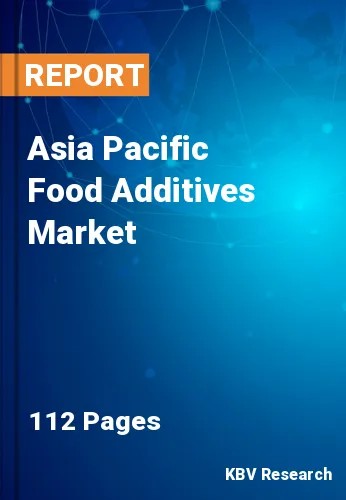The Asia Pacific Food Additives Market would witness market growth of 5.6% CAGR during the forecast period (2021-2027).
The need to improve food and beverage taste, mouthfeel, texture, and overall appearance would drive demand for food additives. Because of shifting population dietary trends, packaged food and beverage consumption is increasing over the region. This is predicted to contribute to the rising demand for food additives used to increase the quality and nutritional content of processed foods. Sugar, fat, and overall calorie content in foods and beverages are being reduced by food and beverage firms. Regulatory approvals for low-calorie sweeteners and fat replacers would pave the way for the production of low-sugar, low-fat foods, and beverages.
To avoid contamination and preservation, raw materials utilized in the manufacturing process are obtained from either natural sources such as plants or chemically generated. Soybean, sunflower, rapeseed, palm oil, glycerol, and sugarcane are among the key raw materials utilized in the manufacturing process. The market growth, however, may be hampered by shifting raw material prices. To meet the rising demand from the food and beverage industries, companies are increasingly collaborating and forming joint ventures.
The regional market is observing a rise in demand for processed foods. In addition, India is the world's largest producer of milk, and the demand for flavored milk, recombined milk, and other products necessitate the use of food additives such as food colors in the business. For example, emulsifiers are widely utilized in the ice cream industry, particularly E4701, which aids in viscosity, stability, and fat reduction and is found in brands such as Amul ice cream.
Clean label ingredients with label claims such as 100 percent natural, non-GMO, and others are in high demand in China. Cargill Inc., AIPU Food Industry Co. Ltd., BASF SE, and other companies are pursuing various tactics to improve their market position. The Malaysian Ministry of Health approved SweeGen's zero-calorie Bestevia sweeteners, Rebaudioside D, E, and M, for use in food and beverage goods in May 2021.
The China market dominated the Asia Pacific Food Additives Market by Country 2020, and would continue to be a dominant market till 2027; thereby, achieving a market value of $13,767.3 million by 2027. The Japan market is poised to grow at a CAGR of 4.9% during (2021 - 2027). Additionally, The India market would display a CAGR of 6.3% during (2021 - 2027).
Based on Source, the market is segmented into Natural and Synthetic. Based on Product, the market is segmented into Sweeteners, Flavors & Enhancers, Emulsifiers & Shelf-life Stabilizers, Enzymes, Fat Replacers, Prebiotics & Probiotics, Dietary Fibers, and Others. Based on Application, the market is segmented into Bakery & confectionery, Beverages, Convenience Foods, Dairy & Frozen Desserts, Spices, Condiments, Sauces & Dressings, and Others. Based on countries, the market is segmented into China, Japan, India, South Korea, Singapore, Malaysia, and Rest of Asia Pacific.
Free Valuable Insights: The Worldwide Food Additives Market is Projected to reach USD 135.2 Billion by 2027, at a CAGR of 5.2%
The market research report covers the analysis of key stake holders of the market. Key companies profiled in the report include BASF SE, Kerry Group PLC, Novozymes A/S, Archer Daniels Midland Company, International Flavors & Fragrances, Inc., Ingredion, Incorporated, Tate & Lyle PLC, Ajinomoto Co. Inc., Chr. Hansen holding A/S, and Cargill Corporation.
By Source
By Product
By Application
By Country
Our team of dedicated experts can provide you with attractive expansion opportunities for your business.

